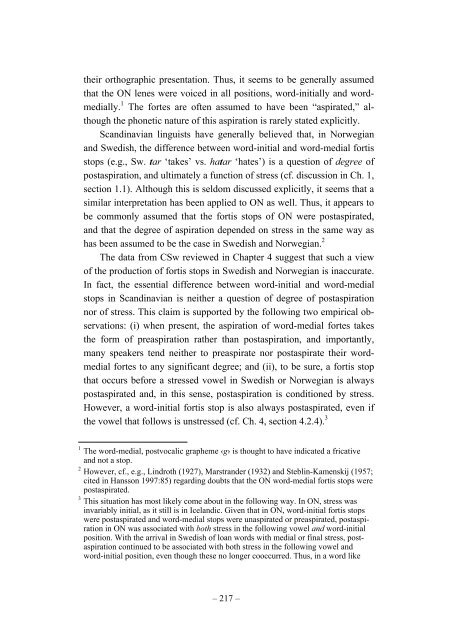Preaspiration in the Nordic Languages: Synchronic and Diachronic ...
Preaspiration in the Nordic Languages: Synchronic and Diachronic ...
Preaspiration in the Nordic Languages: Synchronic and Diachronic ...
Create successful ePaper yourself
Turn your PDF publications into a flip-book with our unique Google optimized e-Paper software.
<strong>the</strong>ir orthographic presentation. Thus, it seems to be generally assumed<br />
that <strong>the</strong> ON lenes were voiced <strong>in</strong> all positions, word-<strong>in</strong>itially <strong>and</strong> wordmedially.<br />
1 The fortes are often assumed to have been “aspirated,” although<br />
<strong>the</strong> phonetic nature of this aspiration is rarely stated explicitly.<br />
Sc<strong>and</strong><strong>in</strong>avian l<strong>in</strong>guists have generally believed that, <strong>in</strong> Norwegian<br />
<strong>and</strong> Swedish, <strong>the</strong> difference between word-<strong>in</strong>itial <strong>and</strong> word-medial fortis<br />
stops (e.g., Sw. tar ‘takes’ vs. hatar ‘hates’) is a question of degree of<br />
postaspiration, <strong>and</strong> ultimately a function of stress (cf. discussion <strong>in</strong> Ch. 1,<br />
section 1.1). Although this is seldom discussed explicitly, it seems that a<br />
similar <strong>in</strong>terpretation has been applied to ON as well. Thus, it appears to<br />
be commonly assumed that <strong>the</strong> fortis stops of ON were postaspirated,<br />
<strong>and</strong> that <strong>the</strong> degree of aspiration depended on stress <strong>in</strong> <strong>the</strong> same way as<br />
has been assumed to be <strong>the</strong> case <strong>in</strong> Swedish <strong>and</strong> Norwegian. 2<br />
The data from CSw reviewed <strong>in</strong> Chapter 4 suggest that such a view<br />
of <strong>the</strong> production of fortis stops <strong>in</strong> Swedish <strong>and</strong> Norwegian is <strong>in</strong>accurate.<br />
In fact, <strong>the</strong> essential difference between word-<strong>in</strong>itial <strong>and</strong> word-medial<br />
stops <strong>in</strong> Sc<strong>and</strong><strong>in</strong>avian is nei<strong>the</strong>r a question of degree of postaspiration<br />
nor of stress. This claim is supported by <strong>the</strong> follow<strong>in</strong>g two empirical observations:<br />
(i) when present, <strong>the</strong> aspiration of word-medial fortes takes<br />
<strong>the</strong> form of preaspiration ra<strong>the</strong>r than postaspiration, <strong>and</strong> importantly,<br />
many speakers tend nei<strong>the</strong>r to preaspirate nor postaspirate <strong>the</strong>ir wordmedial<br />
fortes to any significant degree; <strong>and</strong> (ii), to be sure, a fortis stop<br />
that occurs before a stressed vowel <strong>in</strong> Swedish or Norwegian is always<br />
postaspirated <strong>and</strong>, <strong>in</strong> this sense, postaspiration is conditioned by stress.<br />
However, a word-<strong>in</strong>itial fortis stop is also always postaspirated, even if<br />
<strong>the</strong> vowel that follows is unstressed (cf. Ch. 4, section 4.2.4). 3<br />
1<br />
The word-medial, postvocalic grapheme ‹g› is thought to have <strong>in</strong>dicated a fricative<br />
<strong>and</strong> not a stop.<br />
2<br />
However, cf., e.g., L<strong>in</strong>droth (1927), Marstr<strong>and</strong>er (1932) <strong>and</strong> Stebl<strong>in</strong>-Kamenskij (1957;<br />
cited <strong>in</strong> Hansson 1997:85) regard<strong>in</strong>g doubts that <strong>the</strong> ON word-medial fortis stops were<br />
postaspirated.<br />
3<br />
This situation has most likely come about <strong>in</strong> <strong>the</strong> follow<strong>in</strong>g way. In ON, stress was<br />
<strong>in</strong>variably <strong>in</strong>itial, as it still is <strong>in</strong> Icel<strong>and</strong>ic. Given that <strong>in</strong> ON, word-<strong>in</strong>itial fortis stops<br />
were postaspirated <strong>and</strong> word-medial stops were unaspirated or preaspirated, postaspiration<br />
<strong>in</strong> ON was associated with both stress <strong>in</strong> <strong>the</strong> follow<strong>in</strong>g vowel <strong>and</strong> word-<strong>in</strong>itial<br />
position. With <strong>the</strong> arrival <strong>in</strong> Swedish of loan words with medial or f<strong>in</strong>al stress, postaspiration<br />
cont<strong>in</strong>ued to be associated with both stress <strong>in</strong> <strong>the</strong> follow<strong>in</strong>g vowel <strong>and</strong><br />
word-<strong>in</strong>itial position, even though <strong>the</strong>se no longer cooccurred. Thus, <strong>in</strong> a word like<br />
– 217 –

















